FIAC214 - Financial Analysis Report: ANZ Bank Performance Review
VerifiedAdded on 2022/11/26
|13
|2375
|122
Report
AI Summary
This report provides a comprehensive financial analysis of ANZ Bank (Australia and New Zealand Banking Group Limited), evaluating its performance based on its annual report. The analysis includes a review of the director's and auditor's reports, highlighting key changes in financial items such as net interest income, cash flow from operating activities, and retained earnings. The report investigates the trends and contributing factors behind these changes. Furthermore, it calculates and interprets various financial ratios, including profitability, liquidity, efficiency, and solvency ratios, to assess the bank's financial position. The report concludes with an overview of the bank's financial health and performance based on the analysis of the financial statements.
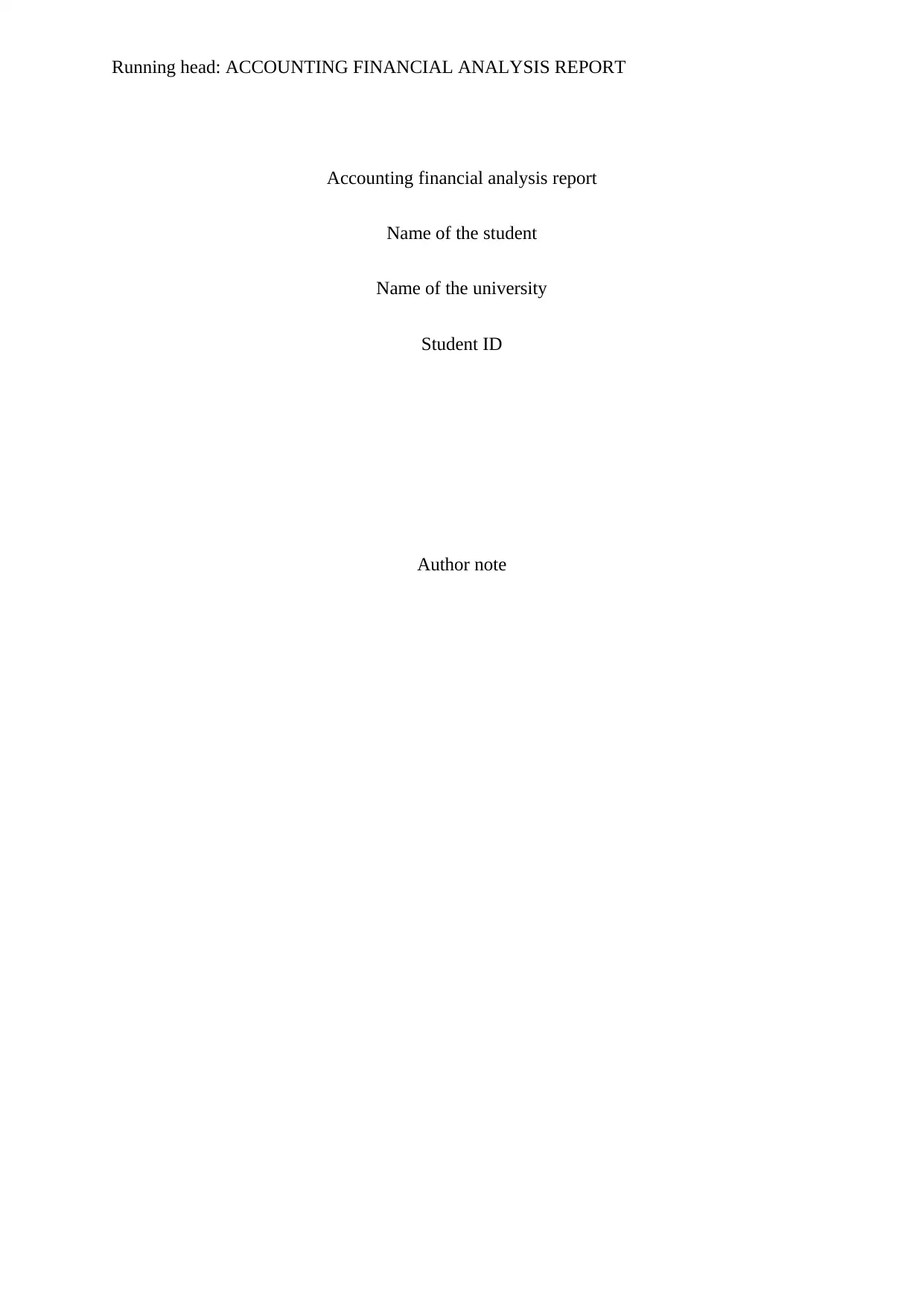
Running head: ACCOUNTING FINANCIAL ANALYSIS REPORT
Accounting financial analysis report
Name of the student
Name of the university
Student ID
Author note
Accounting financial analysis report
Name of the student
Name of the university
Student ID
Author note
Paraphrase This Document
Need a fresh take? Get an instant paraphrase of this document with our AI Paraphraser
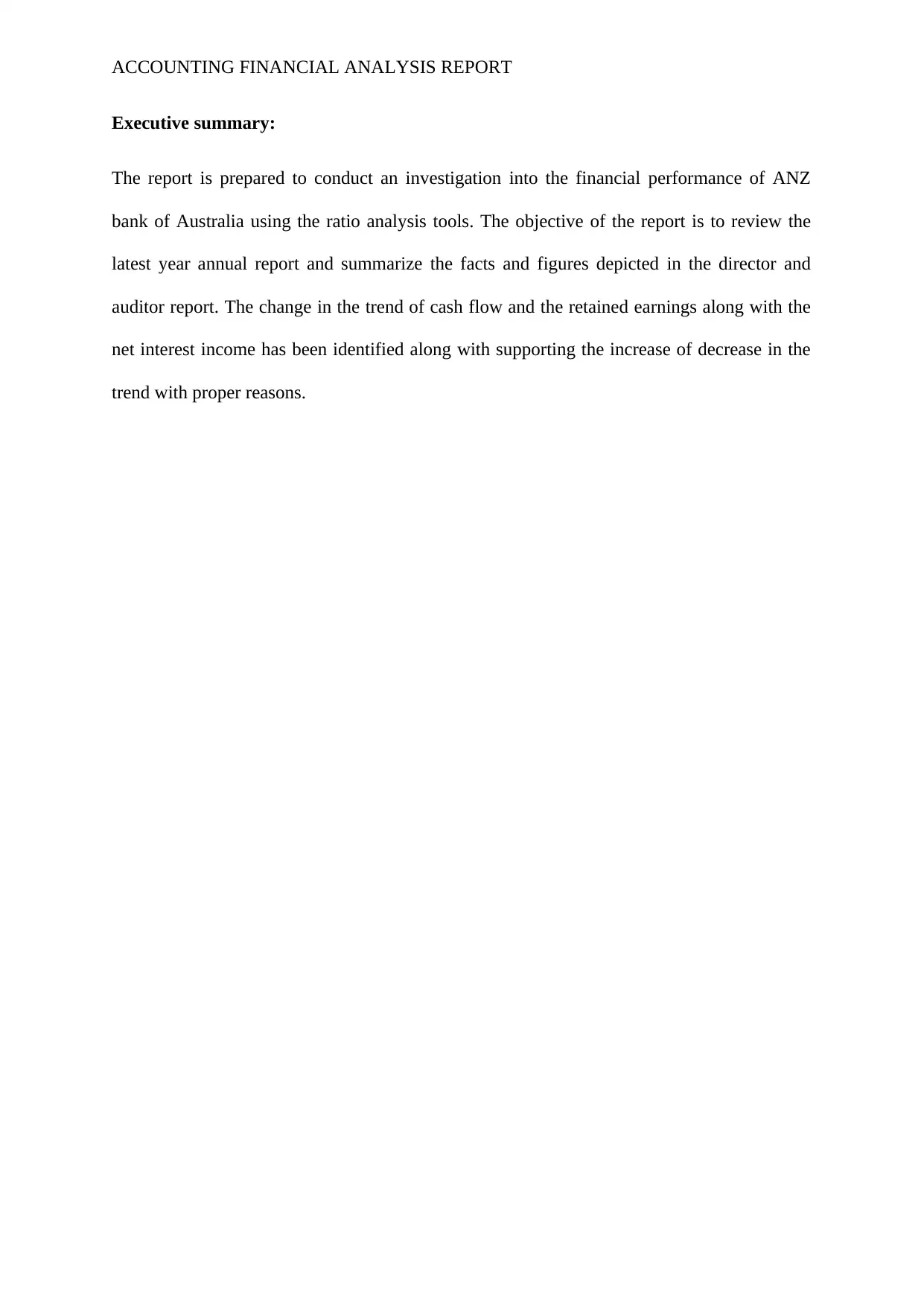
ACCOUNTING FINANCIAL ANALYSIS REPORT
Executive summary:
The report is prepared to conduct an investigation into the financial performance of ANZ
bank of Australia using the ratio analysis tools. The objective of the report is to review the
latest year annual report and summarize the facts and figures depicted in the director and
auditor report. The change in the trend of cash flow and the retained earnings along with the
net interest income has been identified along with supporting the increase of decrease in the
trend with proper reasons.
Executive summary:
The report is prepared to conduct an investigation into the financial performance of ANZ
bank of Australia using the ratio analysis tools. The objective of the report is to review the
latest year annual report and summarize the facts and figures depicted in the director and
auditor report. The change in the trend of cash flow and the retained earnings along with the
net interest income has been identified along with supporting the increase of decrease in the
trend with proper reasons.
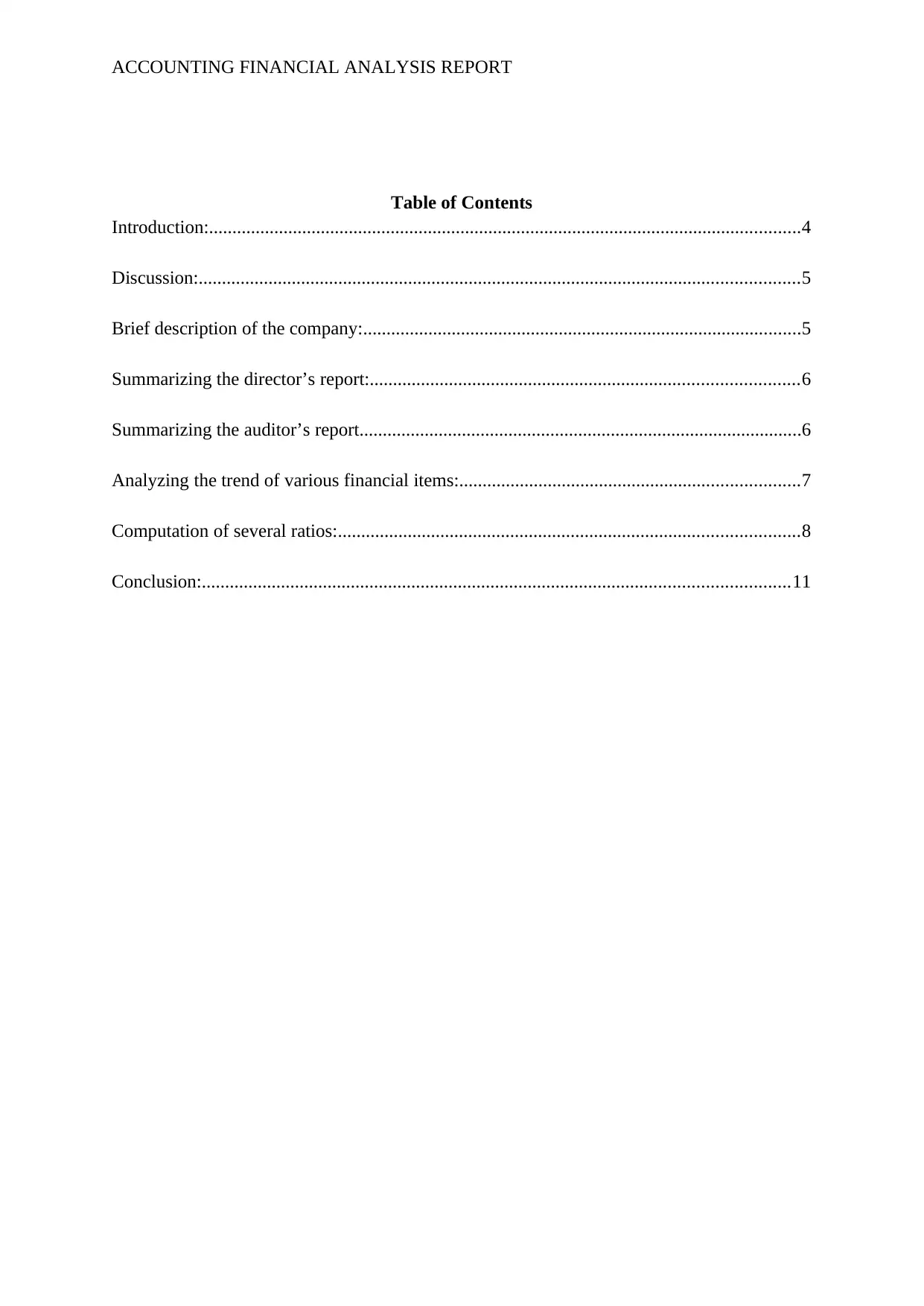
ACCOUNTING FINANCIAL ANALYSIS REPORT
Table of Contents
Introduction:...............................................................................................................................4
Discussion:.................................................................................................................................5
Brief description of the company:..............................................................................................5
Summarizing the director’s report:............................................................................................6
Summarizing the auditor’s report...............................................................................................6
Analyzing the trend of various financial items:.........................................................................7
Computation of several ratios:...................................................................................................8
Conclusion:..............................................................................................................................11
Table of Contents
Introduction:...............................................................................................................................4
Discussion:.................................................................................................................................5
Brief description of the company:..............................................................................................5
Summarizing the director’s report:............................................................................................6
Summarizing the auditor’s report...............................................................................................6
Analyzing the trend of various financial items:.........................................................................7
Computation of several ratios:...................................................................................................8
Conclusion:..............................................................................................................................11
⊘ This is a preview!⊘
Do you want full access?
Subscribe today to unlock all pages.

Trusted by 1+ million students worldwide
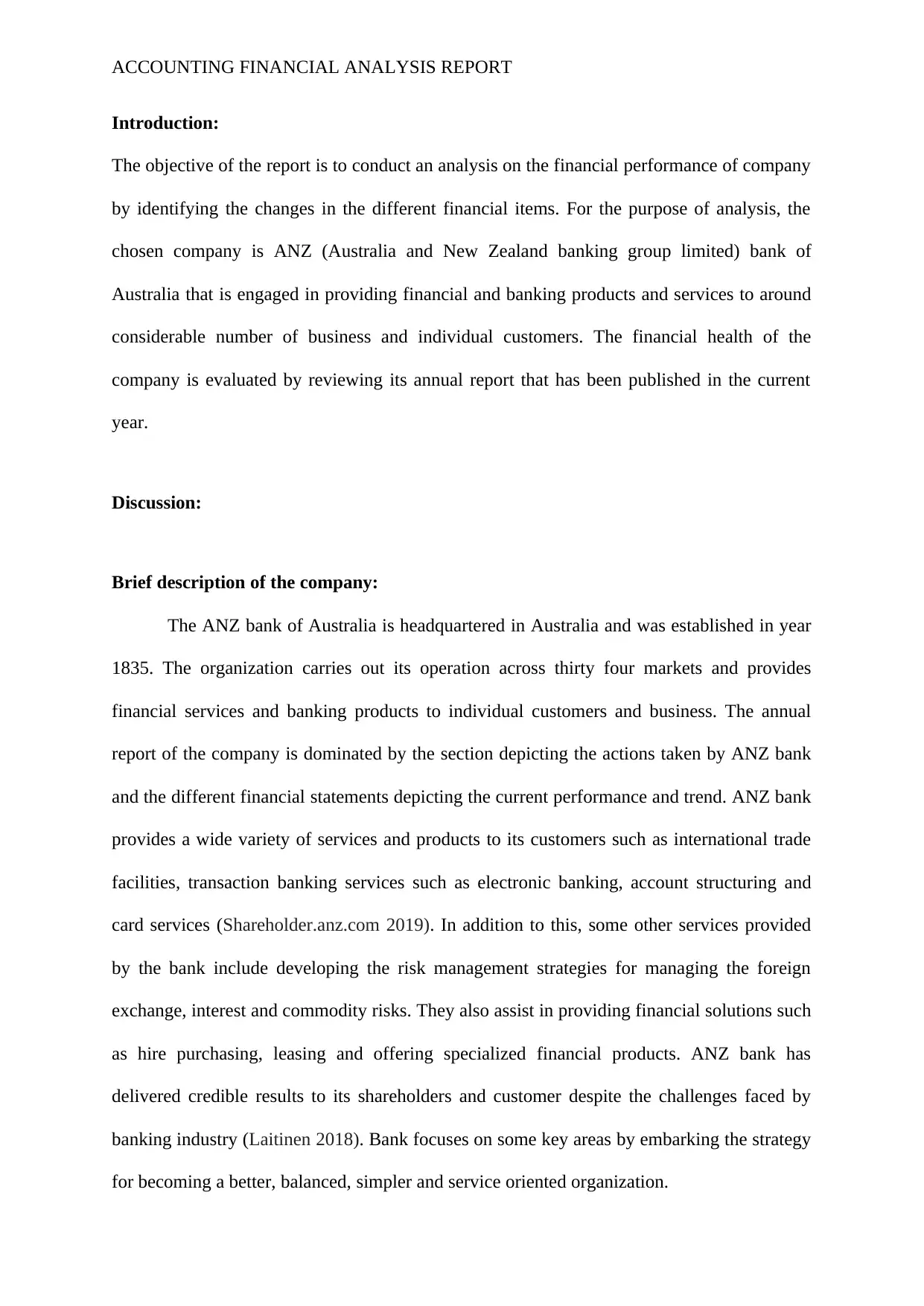
ACCOUNTING FINANCIAL ANALYSIS REPORT
Introduction:
The objective of the report is to conduct an analysis on the financial performance of company
by identifying the changes in the different financial items. For the purpose of analysis, the
chosen company is ANZ (Australia and New Zealand banking group limited) bank of
Australia that is engaged in providing financial and banking products and services to around
considerable number of business and individual customers. The financial health of the
company is evaluated by reviewing its annual report that has been published in the current
year.
Discussion:
Brief description of the company:
The ANZ bank of Australia is headquartered in Australia and was established in year
1835. The organization carries out its operation across thirty four markets and provides
financial services and banking products to individual customers and business. The annual
report of the company is dominated by the section depicting the actions taken by ANZ bank
and the different financial statements depicting the current performance and trend. ANZ bank
provides a wide variety of services and products to its customers such as international trade
facilities, transaction banking services such as electronic banking, account structuring and
card services (Shareholder.anz.com 2019). In addition to this, some other services provided
by the bank include developing the risk management strategies for managing the foreign
exchange, interest and commodity risks. They also assist in providing financial solutions such
as hire purchasing, leasing and offering specialized financial products. ANZ bank has
delivered credible results to its shareholders and customer despite the challenges faced by
banking industry (Laitinen 2018). Bank focuses on some key areas by embarking the strategy
for becoming a better, balanced, simpler and service oriented organization.
Introduction:
The objective of the report is to conduct an analysis on the financial performance of company
by identifying the changes in the different financial items. For the purpose of analysis, the
chosen company is ANZ (Australia and New Zealand banking group limited) bank of
Australia that is engaged in providing financial and banking products and services to around
considerable number of business and individual customers. The financial health of the
company is evaluated by reviewing its annual report that has been published in the current
year.
Discussion:
Brief description of the company:
The ANZ bank of Australia is headquartered in Australia and was established in year
1835. The organization carries out its operation across thirty four markets and provides
financial services and banking products to individual customers and business. The annual
report of the company is dominated by the section depicting the actions taken by ANZ bank
and the different financial statements depicting the current performance and trend. ANZ bank
provides a wide variety of services and products to its customers such as international trade
facilities, transaction banking services such as electronic banking, account structuring and
card services (Shareholder.anz.com 2019). In addition to this, some other services provided
by the bank include developing the risk management strategies for managing the foreign
exchange, interest and commodity risks. They also assist in providing financial solutions such
as hire purchasing, leasing and offering specialized financial products. ANZ bank has
delivered credible results to its shareholders and customer despite the challenges faced by
banking industry (Laitinen 2018). Bank focuses on some key areas by embarking the strategy
for becoming a better, balanced, simpler and service oriented organization.
Paraphrase This Document
Need a fresh take? Get an instant paraphrase of this document with our AI Paraphraser
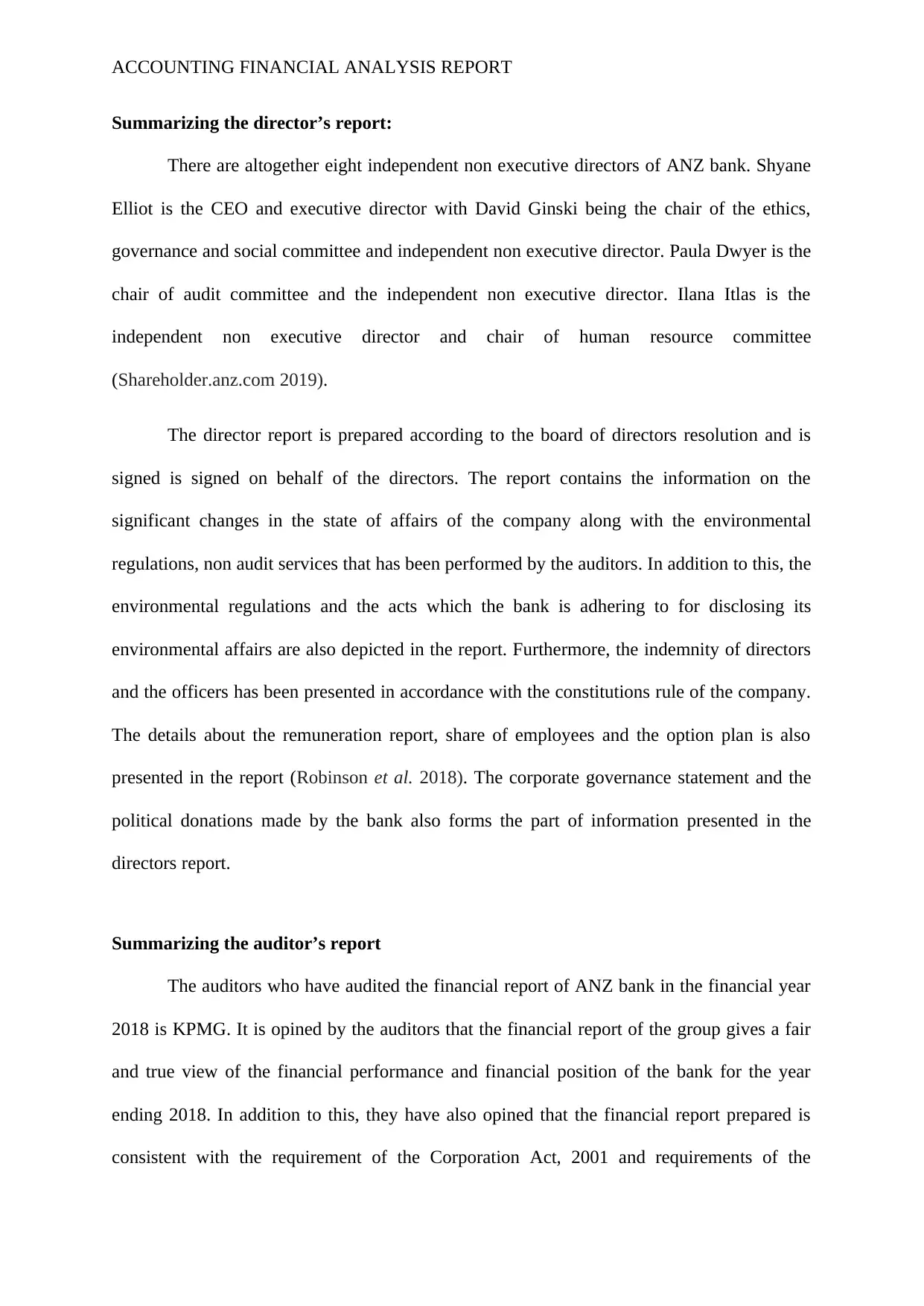
ACCOUNTING FINANCIAL ANALYSIS REPORT
Summarizing the director’s report:
There are altogether eight independent non executive directors of ANZ bank. Shyane
Elliot is the CEO and executive director with David Ginski being the chair of the ethics,
governance and social committee and independent non executive director. Paula Dwyer is the
chair of audit committee and the independent non executive director. Ilana Itlas is the
independent non executive director and chair of human resource committee
(Shareholder.anz.com 2019).
The director report is prepared according to the board of directors resolution and is
signed is signed on behalf of the directors. The report contains the information on the
significant changes in the state of affairs of the company along with the environmental
regulations, non audit services that has been performed by the auditors. In addition to this, the
environmental regulations and the acts which the bank is adhering to for disclosing its
environmental affairs are also depicted in the report. Furthermore, the indemnity of directors
and the officers has been presented in accordance with the constitutions rule of the company.
The details about the remuneration report, share of employees and the option plan is also
presented in the report (Robinson et al. 2018). The corporate governance statement and the
political donations made by the bank also forms the part of information presented in the
directors report.
Summarizing the auditor’s report
The auditors who have audited the financial report of ANZ bank in the financial year
2018 is KPMG. It is opined by the auditors that the financial report of the group gives a fair
and true view of the financial performance and financial position of the bank for the year
ending 2018. In addition to this, they have also opined that the financial report prepared is
consistent with the requirement of the Corporation Act, 2001 and requirements of the
Summarizing the director’s report:
There are altogether eight independent non executive directors of ANZ bank. Shyane
Elliot is the CEO and executive director with David Ginski being the chair of the ethics,
governance and social committee and independent non executive director. Paula Dwyer is the
chair of audit committee and the independent non executive director. Ilana Itlas is the
independent non executive director and chair of human resource committee
(Shareholder.anz.com 2019).
The director report is prepared according to the board of directors resolution and is
signed is signed on behalf of the directors. The report contains the information on the
significant changes in the state of affairs of the company along with the environmental
regulations, non audit services that has been performed by the auditors. In addition to this, the
environmental regulations and the acts which the bank is adhering to for disclosing its
environmental affairs are also depicted in the report. Furthermore, the indemnity of directors
and the officers has been presented in accordance with the constitutions rule of the company.
The details about the remuneration report, share of employees and the option plan is also
presented in the report (Robinson et al. 2018). The corporate governance statement and the
political donations made by the bank also forms the part of information presented in the
directors report.
Summarizing the auditor’s report
The auditors who have audited the financial report of ANZ bank in the financial year
2018 is KPMG. It is opined by the auditors that the financial report of the group gives a fair
and true view of the financial performance and financial position of the bank for the year
ending 2018. In addition to this, they have also opined that the financial report prepared is
consistent with the requirement of the Corporation Act, 2001 and requirements of the
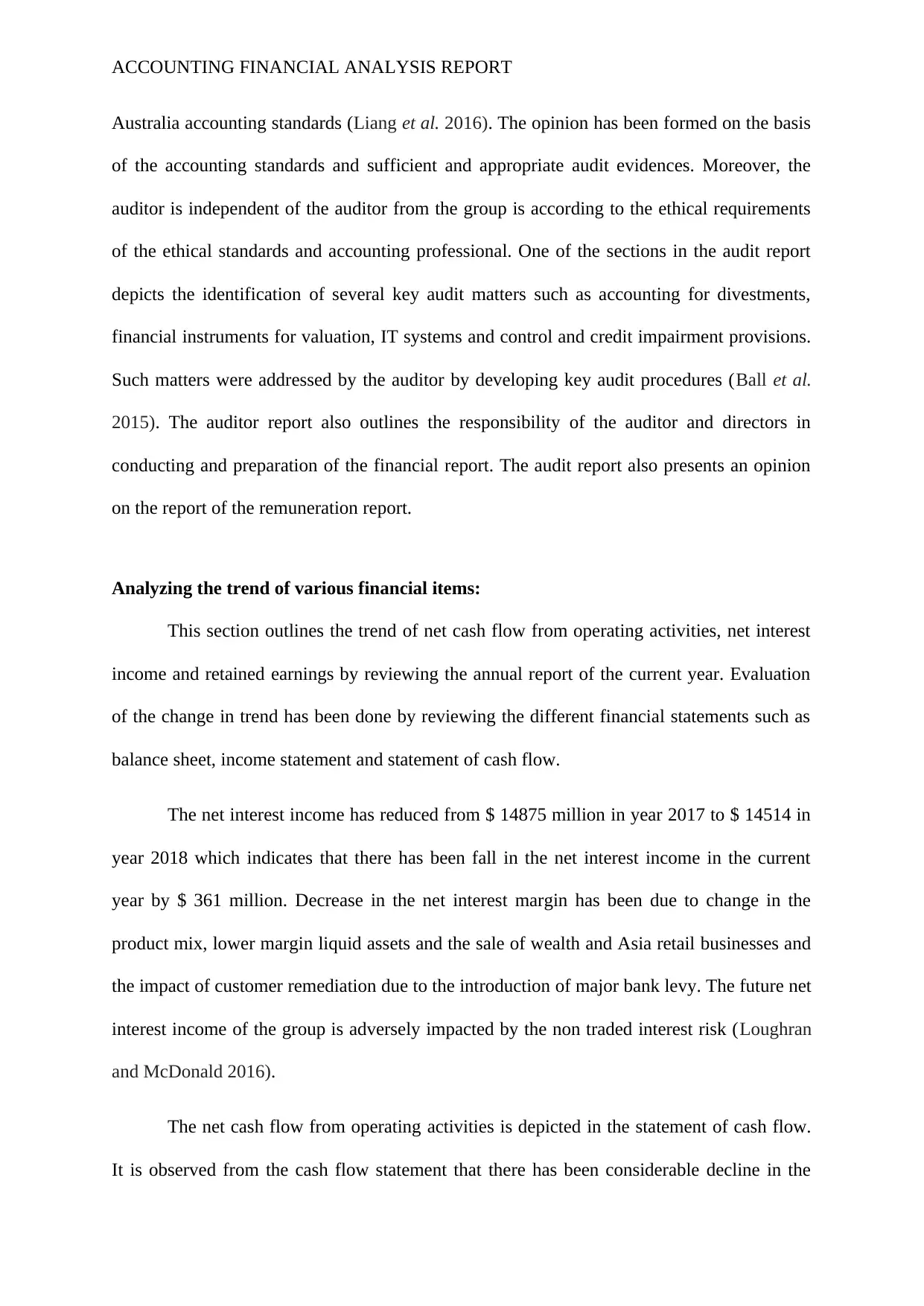
ACCOUNTING FINANCIAL ANALYSIS REPORT
Australia accounting standards (Liang et al. 2016). The opinion has been formed on the basis
of the accounting standards and sufficient and appropriate audit evidences. Moreover, the
auditor is independent of the auditor from the group is according to the ethical requirements
of the ethical standards and accounting professional. One of the sections in the audit report
depicts the identification of several key audit matters such as accounting for divestments,
financial instruments for valuation, IT systems and control and credit impairment provisions.
Such matters were addressed by the auditor by developing key audit procedures (Ball et al.
2015). The auditor report also outlines the responsibility of the auditor and directors in
conducting and preparation of the financial report. The audit report also presents an opinion
on the report of the remuneration report.
Analyzing the trend of various financial items:
This section outlines the trend of net cash flow from operating activities, net interest
income and retained earnings by reviewing the annual report of the current year. Evaluation
of the change in trend has been done by reviewing the different financial statements such as
balance sheet, income statement and statement of cash flow.
The net interest income has reduced from $ 14875 million in year 2017 to $ 14514 in
year 2018 which indicates that there has been fall in the net interest income in the current
year by $ 361 million. Decrease in the net interest margin has been due to change in the
product mix, lower margin liquid assets and the sale of wealth and Asia retail businesses and
the impact of customer remediation due to the introduction of major bank levy. The future net
interest income of the group is adversely impacted by the non traded interest risk (Loughran
and McDonald 2016).
The net cash flow from operating activities is depicted in the statement of cash flow.
It is observed from the cash flow statement that there has been considerable decline in the
Australia accounting standards (Liang et al. 2016). The opinion has been formed on the basis
of the accounting standards and sufficient and appropriate audit evidences. Moreover, the
auditor is independent of the auditor from the group is according to the ethical requirements
of the ethical standards and accounting professional. One of the sections in the audit report
depicts the identification of several key audit matters such as accounting for divestments,
financial instruments for valuation, IT systems and control and credit impairment provisions.
Such matters were addressed by the auditor by developing key audit procedures (Ball et al.
2015). The auditor report also outlines the responsibility of the auditor and directors in
conducting and preparation of the financial report. The audit report also presents an opinion
on the report of the remuneration report.
Analyzing the trend of various financial items:
This section outlines the trend of net cash flow from operating activities, net interest
income and retained earnings by reviewing the annual report of the current year. Evaluation
of the change in trend has been done by reviewing the different financial statements such as
balance sheet, income statement and statement of cash flow.
The net interest income has reduced from $ 14875 million in year 2017 to $ 14514 in
year 2018 which indicates that there has been fall in the net interest income in the current
year by $ 361 million. Decrease in the net interest margin has been due to change in the
product mix, lower margin liquid assets and the sale of wealth and Asia retail businesses and
the impact of customer remediation due to the introduction of major bank levy. The future net
interest income of the group is adversely impacted by the non traded interest risk (Loughran
and McDonald 2016).
The net cash flow from operating activities is depicted in the statement of cash flow.
It is observed from the cash flow statement that there has been considerable decline in the
⊘ This is a preview!⊘
Do you want full access?
Subscribe today to unlock all pages.

Trusted by 1+ million students worldwide
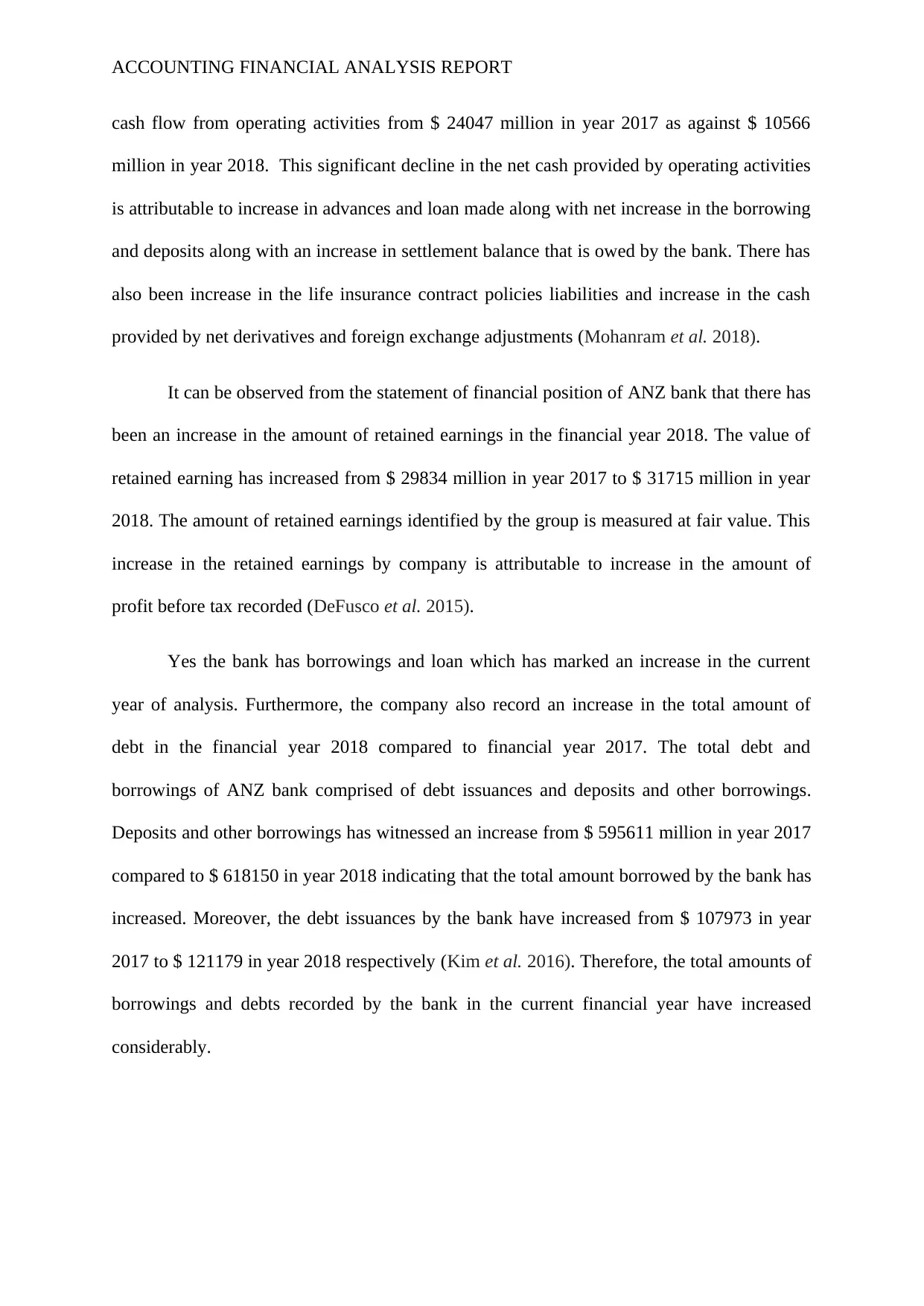
ACCOUNTING FINANCIAL ANALYSIS REPORT
cash flow from operating activities from $ 24047 million in year 2017 as against $ 10566
million in year 2018. This significant decline in the net cash provided by operating activities
is attributable to increase in advances and loan made along with net increase in the borrowing
and deposits along with an increase in settlement balance that is owed by the bank. There has
also been increase in the life insurance contract policies liabilities and increase in the cash
provided by net derivatives and foreign exchange adjustments (Mohanram et al. 2018).
It can be observed from the statement of financial position of ANZ bank that there has
been an increase in the amount of retained earnings in the financial year 2018. The value of
retained earning has increased from $ 29834 million in year 2017 to $ 31715 million in year
2018. The amount of retained earnings identified by the group is measured at fair value. This
increase in the retained earnings by company is attributable to increase in the amount of
profit before tax recorded (DeFusco et al. 2015).
Yes the bank has borrowings and loan which has marked an increase in the current
year of analysis. Furthermore, the company also record an increase in the total amount of
debt in the financial year 2018 compared to financial year 2017. The total debt and
borrowings of ANZ bank comprised of debt issuances and deposits and other borrowings.
Deposits and other borrowings has witnessed an increase from $ 595611 million in year 2017
compared to $ 618150 in year 2018 indicating that the total amount borrowed by the bank has
increased. Moreover, the debt issuances by the bank have increased from $ 107973 in year
2017 to $ 121179 in year 2018 respectively (Kim et al. 2016). Therefore, the total amounts of
borrowings and debts recorded by the bank in the current financial year have increased
considerably.
cash flow from operating activities from $ 24047 million in year 2017 as against $ 10566
million in year 2018. This significant decline in the net cash provided by operating activities
is attributable to increase in advances and loan made along with net increase in the borrowing
and deposits along with an increase in settlement balance that is owed by the bank. There has
also been increase in the life insurance contract policies liabilities and increase in the cash
provided by net derivatives and foreign exchange adjustments (Mohanram et al. 2018).
It can be observed from the statement of financial position of ANZ bank that there has
been an increase in the amount of retained earnings in the financial year 2018. The value of
retained earning has increased from $ 29834 million in year 2017 to $ 31715 million in year
2018. The amount of retained earnings identified by the group is measured at fair value. This
increase in the retained earnings by company is attributable to increase in the amount of
profit before tax recorded (DeFusco et al. 2015).
Yes the bank has borrowings and loan which has marked an increase in the current
year of analysis. Furthermore, the company also record an increase in the total amount of
debt in the financial year 2018 compared to financial year 2017. The total debt and
borrowings of ANZ bank comprised of debt issuances and deposits and other borrowings.
Deposits and other borrowings has witnessed an increase from $ 595611 million in year 2017
compared to $ 618150 in year 2018 indicating that the total amount borrowed by the bank has
increased. Moreover, the debt issuances by the bank have increased from $ 107973 in year
2017 to $ 121179 in year 2018 respectively (Kim et al. 2016). Therefore, the total amounts of
borrowings and debts recorded by the bank in the current financial year have increased
considerably.
Paraphrase This Document
Need a fresh take? Get an instant paraphrase of this document with our AI Paraphraser
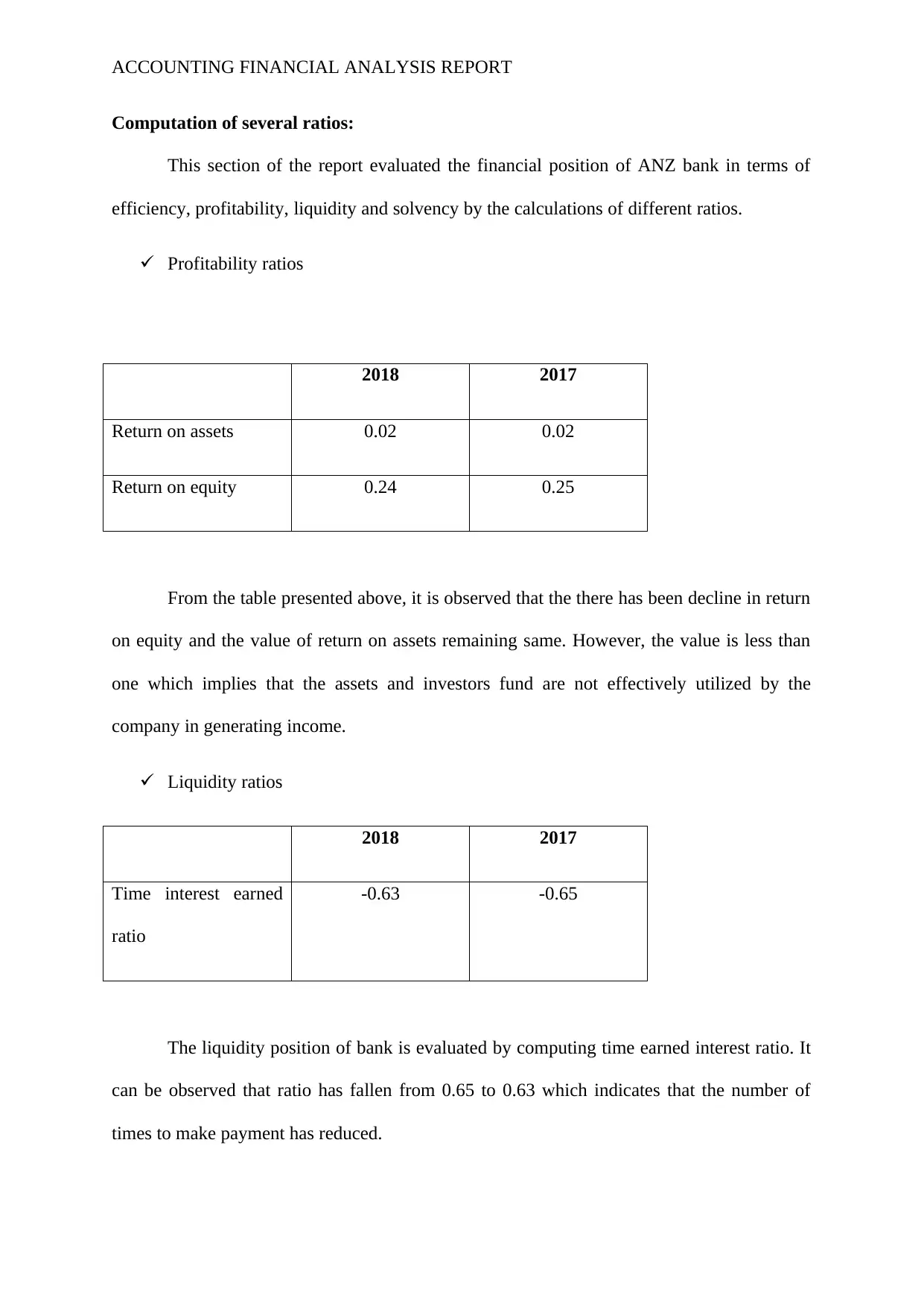
ACCOUNTING FINANCIAL ANALYSIS REPORT
Computation of several ratios:
This section of the report evaluated the financial position of ANZ bank in terms of
efficiency, profitability, liquidity and solvency by the calculations of different ratios.
Profitability ratios
2018 2017
Return on assets 0.02 0.02
Return on equity 0.24 0.25
From the table presented above, it is observed that the there has been decline in return
on equity and the value of return on assets remaining same. However, the value is less than
one which implies that the assets and investors fund are not effectively utilized by the
company in generating income.
Liquidity ratios
2018 2017
Time interest earned
ratio
-0.63 -0.65
The liquidity position of bank is evaluated by computing time earned interest ratio. It
can be observed that ratio has fallen from 0.65 to 0.63 which indicates that the number of
times to make payment has reduced.
Computation of several ratios:
This section of the report evaluated the financial position of ANZ bank in terms of
efficiency, profitability, liquidity and solvency by the calculations of different ratios.
Profitability ratios
2018 2017
Return on assets 0.02 0.02
Return on equity 0.24 0.25
From the table presented above, it is observed that the there has been decline in return
on equity and the value of return on assets remaining same. However, the value is less than
one which implies that the assets and investors fund are not effectively utilized by the
company in generating income.
Liquidity ratios
2018 2017
Time interest earned
ratio
-0.63 -0.65
The liquidity position of bank is evaluated by computing time earned interest ratio. It
can be observed that ratio has fallen from 0.65 to 0.63 which indicates that the number of
times to make payment has reduced.
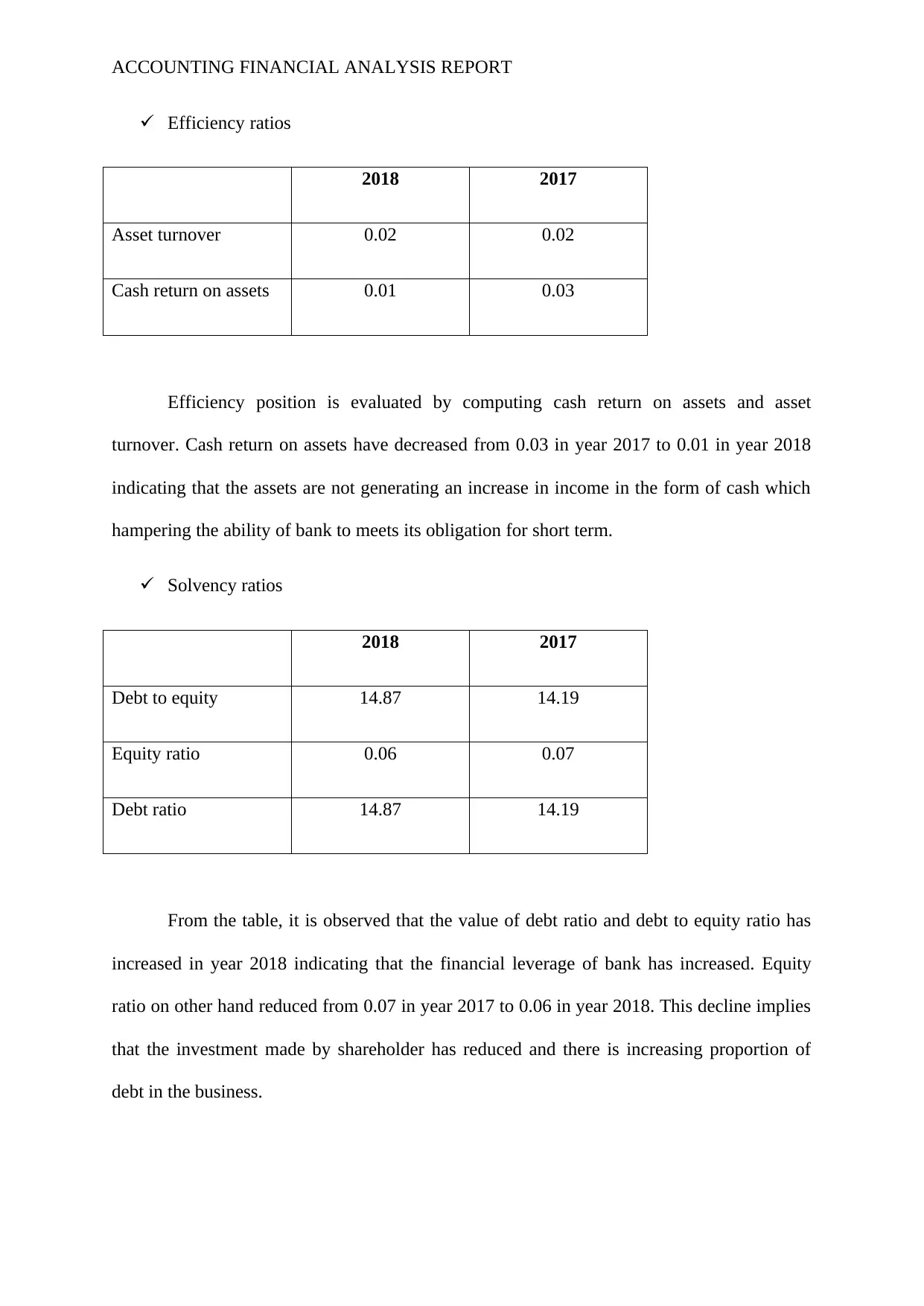
ACCOUNTING FINANCIAL ANALYSIS REPORT
Efficiency ratios
2018 2017
Asset turnover 0.02 0.02
Cash return on assets 0.01 0.03
Efficiency position is evaluated by computing cash return on assets and asset
turnover. Cash return on assets have decreased from 0.03 in year 2017 to 0.01 in year 2018
indicating that the assets are not generating an increase in income in the form of cash which
hampering the ability of bank to meets its obligation for short term.
Solvency ratios
2018 2017
Debt to equity 14.87 14.19
Equity ratio 0.06 0.07
Debt ratio 14.87 14.19
From the table, it is observed that the value of debt ratio and debt to equity ratio has
increased in year 2018 indicating that the financial leverage of bank has increased. Equity
ratio on other hand reduced from 0.07 in year 2017 to 0.06 in year 2018. This decline implies
that the investment made by shareholder has reduced and there is increasing proportion of
debt in the business.
Efficiency ratios
2018 2017
Asset turnover 0.02 0.02
Cash return on assets 0.01 0.03
Efficiency position is evaluated by computing cash return on assets and asset
turnover. Cash return on assets have decreased from 0.03 in year 2017 to 0.01 in year 2018
indicating that the assets are not generating an increase in income in the form of cash which
hampering the ability of bank to meets its obligation for short term.
Solvency ratios
2018 2017
Debt to equity 14.87 14.19
Equity ratio 0.06 0.07
Debt ratio 14.87 14.19
From the table, it is observed that the value of debt ratio and debt to equity ratio has
increased in year 2018 indicating that the financial leverage of bank has increased. Equity
ratio on other hand reduced from 0.07 in year 2017 to 0.06 in year 2018. This decline implies
that the investment made by shareholder has reduced and there is increasing proportion of
debt in the business.
⊘ This is a preview!⊘
Do you want full access?
Subscribe today to unlock all pages.

Trusted by 1+ million students worldwide
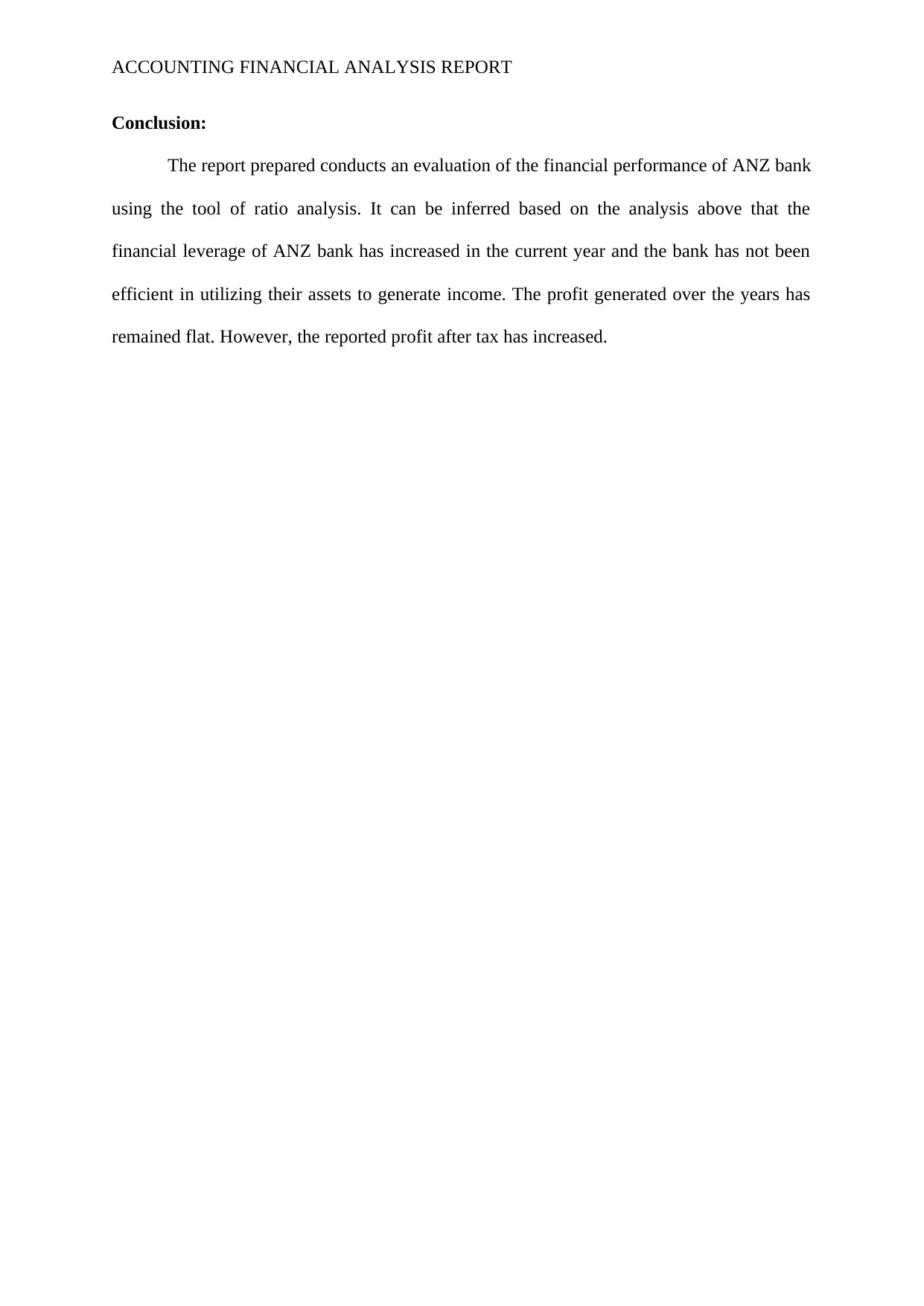
ACCOUNTING FINANCIAL ANALYSIS REPORT
Conclusion:
The report prepared conducts an evaluation of the financial performance of ANZ bank
using the tool of ratio analysis. It can be inferred based on the analysis above that the
financial leverage of ANZ bank has increased in the current year and the bank has not been
efficient in utilizing their assets to generate income. The profit generated over the years has
remained flat. However, the reported profit after tax has increased.
Conclusion:
The report prepared conducts an evaluation of the financial performance of ANZ bank
using the tool of ratio analysis. It can be inferred based on the analysis above that the
financial leverage of ANZ bank has increased in the current year and the bank has not been
efficient in utilizing their assets to generate income. The profit generated over the years has
remained flat. However, the reported profit after tax has increased.
Paraphrase This Document
Need a fresh take? Get an instant paraphrase of this document with our AI Paraphraser
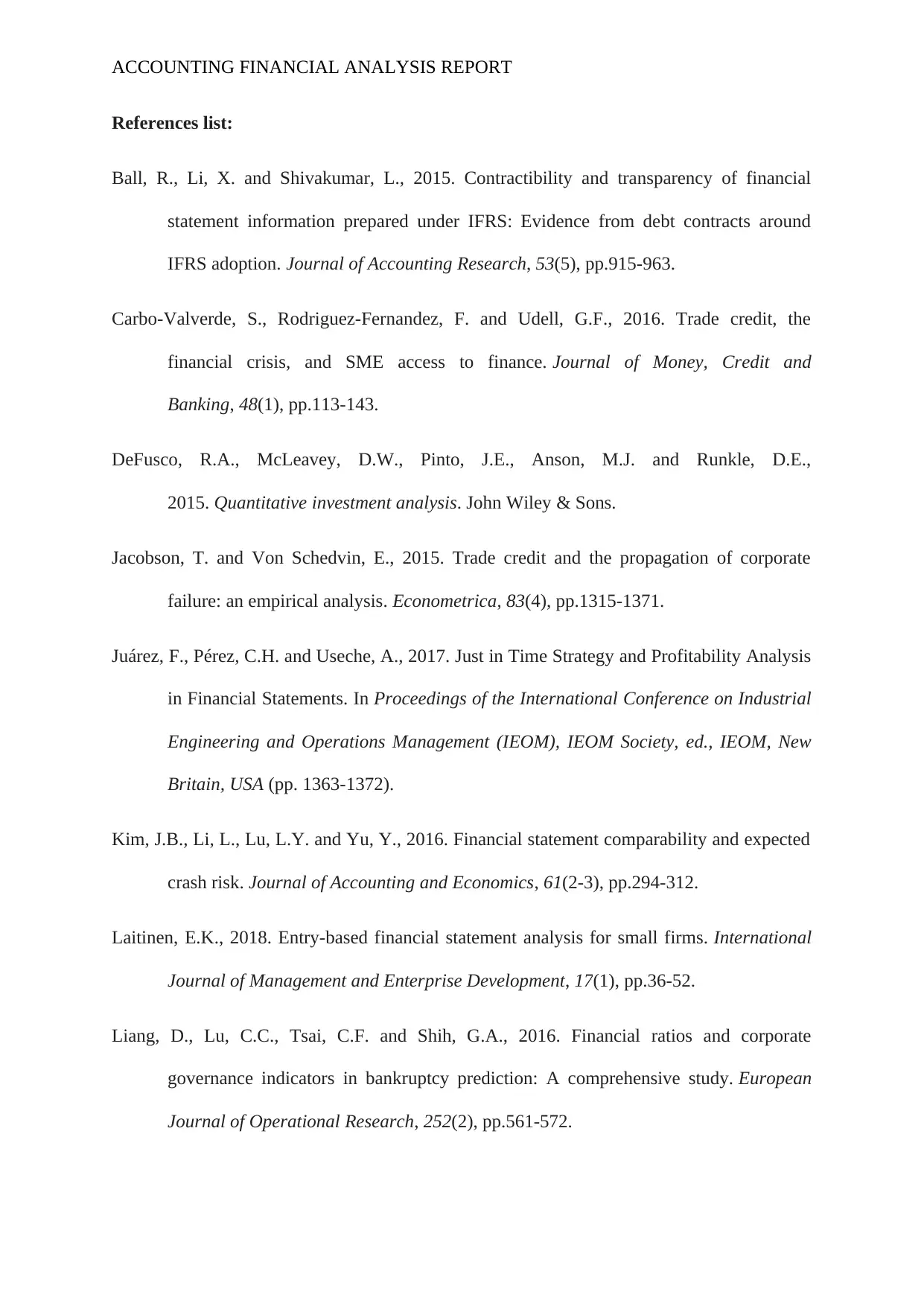
ACCOUNTING FINANCIAL ANALYSIS REPORT
References list:
Ball, R., Li, X. and Shivakumar, L., 2015. Contractibility and transparency of financial
statement information prepared under IFRS: Evidence from debt contracts around
IFRS adoption. Journal of Accounting Research, 53(5), pp.915-963.
Carbo‐Valverde, S., Rodriguez‐Fernandez, F. and Udell, G.F., 2016. Trade credit, the
financial crisis, and SME access to finance. Journal of Money, Credit and
Banking, 48(1), pp.113-143.
DeFusco, R.A., McLeavey, D.W., Pinto, J.E., Anson, M.J. and Runkle, D.E.,
2015. Quantitative investment analysis. John Wiley & Sons.
Jacobson, T. and Von Schedvin, E., 2015. Trade credit and the propagation of corporate
failure: an empirical analysis. Econometrica, 83(4), pp.1315-1371.
Juárez, F., Pérez, C.H. and Useche, A., 2017. Just in Time Strategy and Profitability Analysis
in Financial Statements. In Proceedings of the International Conference on Industrial
Engineering and Operations Management (IEOM), IEOM Society, ed., IEOM, New
Britain, USA (pp. 1363-1372).
Kim, J.B., Li, L., Lu, L.Y. and Yu, Y., 2016. Financial statement comparability and expected
crash risk. Journal of Accounting and Economics, 61(2-3), pp.294-312.
Laitinen, E.K., 2018. Entry-based financial statement analysis for small firms. International
Journal of Management and Enterprise Development, 17(1), pp.36-52.
Liang, D., Lu, C.C., Tsai, C.F. and Shih, G.A., 2016. Financial ratios and corporate
governance indicators in bankruptcy prediction: A comprehensive study. European
Journal of Operational Research, 252(2), pp.561-572.
References list:
Ball, R., Li, X. and Shivakumar, L., 2015. Contractibility and transparency of financial
statement information prepared under IFRS: Evidence from debt contracts around
IFRS adoption. Journal of Accounting Research, 53(5), pp.915-963.
Carbo‐Valverde, S., Rodriguez‐Fernandez, F. and Udell, G.F., 2016. Trade credit, the
financial crisis, and SME access to finance. Journal of Money, Credit and
Banking, 48(1), pp.113-143.
DeFusco, R.A., McLeavey, D.W., Pinto, J.E., Anson, M.J. and Runkle, D.E.,
2015. Quantitative investment analysis. John Wiley & Sons.
Jacobson, T. and Von Schedvin, E., 2015. Trade credit and the propagation of corporate
failure: an empirical analysis. Econometrica, 83(4), pp.1315-1371.
Juárez, F., Pérez, C.H. and Useche, A., 2017. Just in Time Strategy and Profitability Analysis
in Financial Statements. In Proceedings of the International Conference on Industrial
Engineering and Operations Management (IEOM), IEOM Society, ed., IEOM, New
Britain, USA (pp. 1363-1372).
Kim, J.B., Li, L., Lu, L.Y. and Yu, Y., 2016. Financial statement comparability and expected
crash risk. Journal of Accounting and Economics, 61(2-3), pp.294-312.
Laitinen, E.K., 2018. Entry-based financial statement analysis for small firms. International
Journal of Management and Enterprise Development, 17(1), pp.36-52.
Liang, D., Lu, C.C., Tsai, C.F. and Shih, G.A., 2016. Financial ratios and corporate
governance indicators in bankruptcy prediction: A comprehensive study. European
Journal of Operational Research, 252(2), pp.561-572.
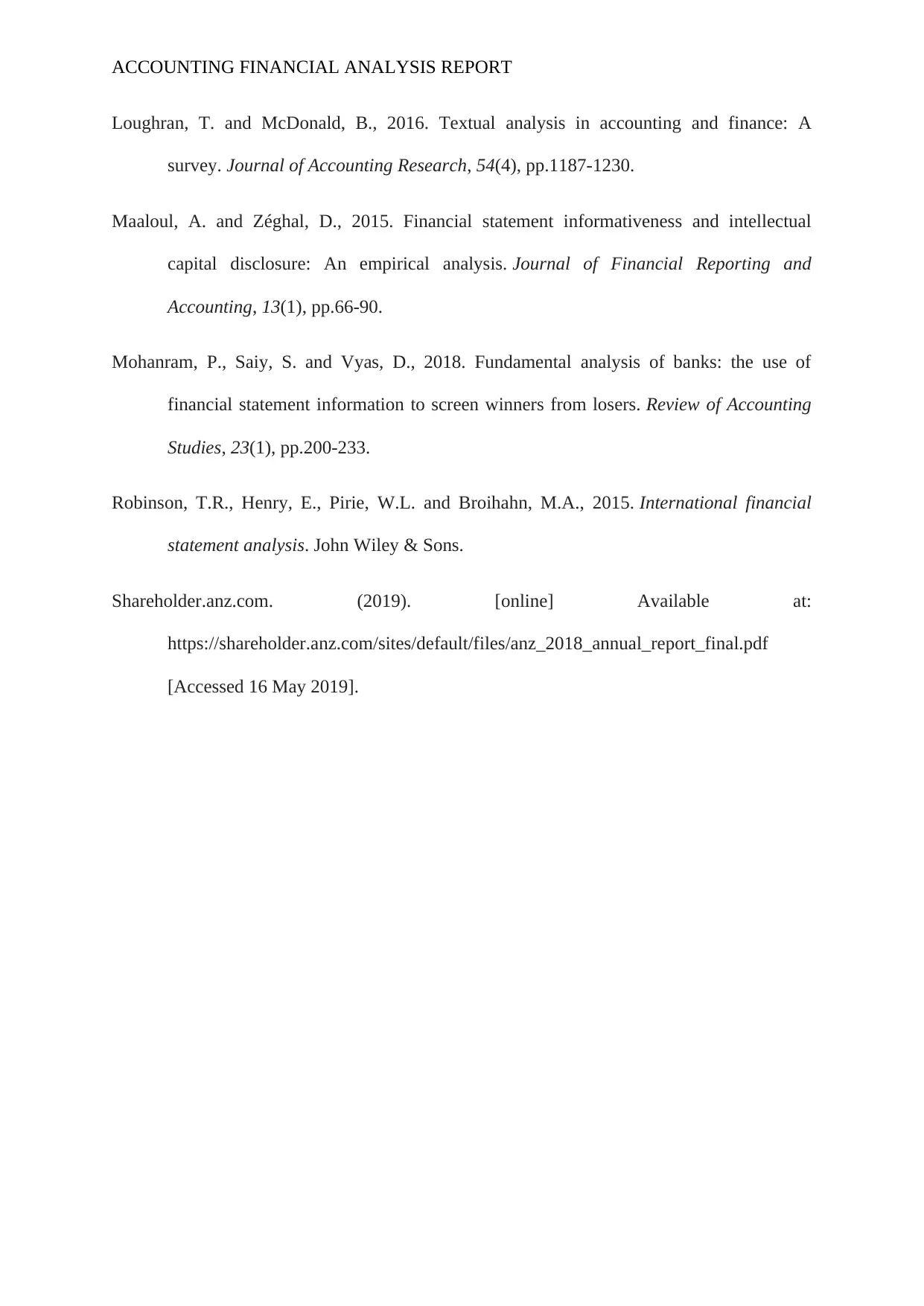
ACCOUNTING FINANCIAL ANALYSIS REPORT
Loughran, T. and McDonald, B., 2016. Textual analysis in accounting and finance: A
survey. Journal of Accounting Research, 54(4), pp.1187-1230.
Maaloul, A. and Zéghal, D., 2015. Financial statement informativeness and intellectual
capital disclosure: An empirical analysis. Journal of Financial Reporting and
Accounting, 13(1), pp.66-90.
Mohanram, P., Saiy, S. and Vyas, D., 2018. Fundamental analysis of banks: the use of
financial statement information to screen winners from losers. Review of Accounting
Studies, 23(1), pp.200-233.
Robinson, T.R., Henry, E., Pirie, W.L. and Broihahn, M.A., 2015. International financial
statement analysis. John Wiley & Sons.
Shareholder.anz.com. (2019). [online] Available at:
https://shareholder.anz.com/sites/default/files/anz_2018_annual_report_final.pdf
[Accessed 16 May 2019].
Loughran, T. and McDonald, B., 2016. Textual analysis in accounting and finance: A
survey. Journal of Accounting Research, 54(4), pp.1187-1230.
Maaloul, A. and Zéghal, D., 2015. Financial statement informativeness and intellectual
capital disclosure: An empirical analysis. Journal of Financial Reporting and
Accounting, 13(1), pp.66-90.
Mohanram, P., Saiy, S. and Vyas, D., 2018. Fundamental analysis of banks: the use of
financial statement information to screen winners from losers. Review of Accounting
Studies, 23(1), pp.200-233.
Robinson, T.R., Henry, E., Pirie, W.L. and Broihahn, M.A., 2015. International financial
statement analysis. John Wiley & Sons.
Shareholder.anz.com. (2019). [online] Available at:
https://shareholder.anz.com/sites/default/files/anz_2018_annual_report_final.pdf
[Accessed 16 May 2019].
⊘ This is a preview!⊘
Do you want full access?
Subscribe today to unlock all pages.

Trusted by 1+ million students worldwide
1 out of 13
Related Documents
Your All-in-One AI-Powered Toolkit for Academic Success.
+13062052269
info@desklib.com
Available 24*7 on WhatsApp / Email
![[object Object]](/_next/static/media/star-bottom.7253800d.svg)
Unlock your academic potential
Copyright © 2020–2025 A2Z Services. All Rights Reserved. Developed and managed by ZUCOL.





